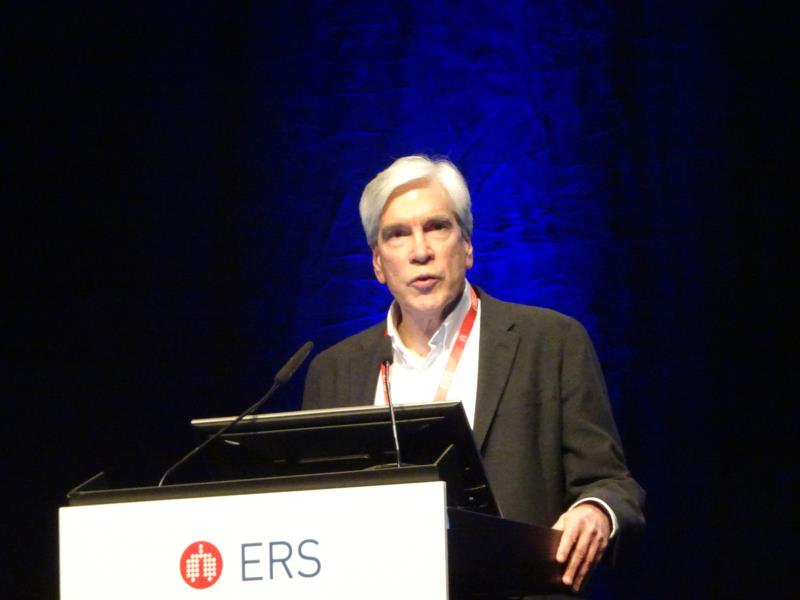 Dr Gerard Criner
Dr Gerard CrinerHaving elevated blood eosinophil counts (BEC) along with three other clinical characteristics help identify a subgroup of patients with COPD* who are most likely to benefit from benralizumab in terms of exacerbation reduction, according to a prespecified pooled analysis of the phase III GALATHEA and TERRANOVA** trials.
Previously, benralizumab failed to reach statistically significant reductions in exacerbation rate compared with placebo for the primary analysis population with BEC ≥200 cell/µL, as reported in the ATS*** 2019 Meeting.
To identify potential baseline clinical characteristics that would predict reduction in COPD exacerbations with benralizumab, the researchers performed a prespecified analysis of the individual and pooled results from the two studies — this time involving a subpopulation of 2,665 patients (mean age 65.3 years, 34 percent women) with BEC ≥220 cell/µL.
“BEC, by itself, is not sufficient for identifying patients who respond to benralizumab,” said Dr Gerard Criner of Lewis Katz School of Medicine at Temple University, Philadelphia, Pennsylvania, US, who presented the results at ERS 2019.
However, taking BEC ≥220 cell/µL into consideration with the addition of clinical characteristics — based on frequent prior exacerbations of ≥3 times in the previous year, poor baseline lung function <40 percent, and post-bronchodilator [BD] FEV1# improvement ≥15 percent — Criner and colleagues identified the clinical predictors of patients who would have a better response to benralizumab. [ERS 2019, abstract RCT446; Lancet Respir Med 2019;doi:10.1016/S2213-2600(19)30338-8]
Beyond BEC
“Having a history of more frequent exacerbation of ≥3 was a strong predictor of enhanced response to benralizumab 100 mg Q8W vs placebo in reducing exacerbations,” said Criner, who reported that the annual exacerbation rate (AER) was reduced by 39 percent in GALATHEA and by 23 percent in TERRANOVA, in favour of benralizumab.
In addition, having a poorer baseline post-BD FEV1 of <40 percent predicted a greater exacerbation rate reduction in both GALATHEA (by 31 percent) and TERRANOVA (by 29 percent) with benralizumab over placebo.
Pooled analysis of both studies also showed that frequent prior exacerbations of ≥3 (rate ratio [RR], 0.69), poor baseline lung function of <40 percent (RR, 0.76), and post-BD FEV1 response of ≥15 percent (RR, 0.66) were predictive factors of response to benralizumab, consistent with results from the individual studies.
These predictive factors only applied to patients with baseline BEC ≥220 cells/uL, stated Criner. “No factors were identified that predicted treatment response for patients with baseline BEC <220 cells/uL.”
“We believe that the clinical history adds to BEC to predict the patient population who may respond to this therapy,” he added.
Also, the more baseline factors that a patient has, the greater the benefit derived: exacerbation rate reducton (ERR) with benralizumab vs placebo was 12 percent in patients with BEC ≥220 cells/µL alone and 19 percent in those with BEC ≥220 cells/µL and were receiving triple therapy. Adding the factor of ≥3 exacerbations to the other two predictors further improved the ERR to 30 percent.
“To benefit from these new therapies, a patient needs to have not only the trait that will respond to the treatment but also the necessary risk that will be reduced. Hence, the need to have a high baseline exacerbation rate as well as a high eosinophil count,” wrote Drs Sanjay Ramakrishnan and Richard Russell of University of Oxford, Oxford, UK, in a linked commentary. [Lancet Respir Med 2019;doi: doi.org/10.1016/S2213-2600(19)30340-6]
Nonetheless, these analyses are hypothesis generating and need to be confirmed in prospective clinical trials. “A phase III trial, RESOLUTE, is currently underway for this population to confirm the hypothesis,” informed Criner.
If confirmed in future studies, these predictors could help guide patient selection for receiving the therapy, he said.
Moving towards precision medicine
“In the attempt for precision medicine in the future, especially with therapies that are expensive, getting the right therapy into the right population determined by the risk and the clinical characteristics have to be done in combination,” said Criner.
Noting that BEC is not that stable as once assumed, session cochair Dr Daiana Stolz from University Hospital Basel in Basel, Switzerland asked, how informative is just one measurement and how often are repeat measurements needed?
As the BEC threshold was based on randomized clinical trial, which does not necessarily reflect real-world practice, Criner responded that this calls for more pragmatic trials to answer the question on the durability of a signature such as BEC.